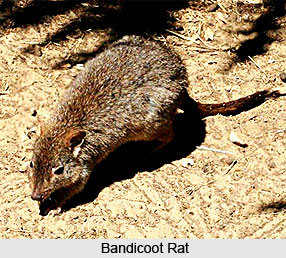 The Bandicoot Rats of Asia are true rodents and should not be confused with the rat-like marsupials of Australia which are called simply Bandicoots. Bandicoot rats are similar to Sewer Rats but can be distinguished by long guard hairs scattered over the back and by their more protruding incisors. Bandicoot rats are highly aggressive, emitting harsh grunts when disturbed.
The Bandicoot Rats of Asia are true rodents and should not be confused with the rat-like marsupials of Australia which are called simply Bandicoots. Bandicoot rats are similar to Sewer Rats but can be distinguished by long guard hairs scattered over the back and by their more protruding incisors. Bandicoot rats are highly aggressive, emitting harsh grunts when disturbed.
There are two species of bandicoot rats namely the Lesser Bandicoot. This species of Bandicoot Rats weighs 250 grams and are slightly smaller in size. The second is the Indian Bandicoot, which weighs one kilogram or more and is the largest rat in Asia.
Both species are found over most of the Indo-Malayan region, but within this area the Indian Bandicoot Rat is less widespread, and is more common in rural areas than in cities.
The Lesser Bandicoot Rat is undoubtedly the most serious rodent pest in South Asia. It has become the most abundant rodent species in many of the large cities within its range while other rat species have declined proportionally. It can carry plague as well as typhus, leptospirosis, salmonellosis and rat-bite fever. Since bandicoots live in houses and contaminate food with their faeces and urine, they can easily spread these diseases to man. Infestations of this rat in grain godowns of Kolkata are so great that the number of rats feeding in a godown was estimated to exceed two rats per square meter of floor space. Lesser Bandicoots are also extremely well adapted for exploiting crops in the field.
Bandicoots can build up large fat reserves when food is abundant. They may weigh twice the normal adult weight after several weeks of good feeding. They survive months of drought by remaining underground and by feeding on stored food and tuberous roots and utilizing their fat reserves. When the rains return and the next crop is planted, bandicoots are again ready to take their share.
These rats can be controlled in several ways. For instance on the farm, removal of weeds from the crop and from field edges means less cover for rats and less food before the crop ripens. Ploughing fields immediately after harvest breaks up rat burrows. Use of rat poisons as the crop matures can kill most of the rats that remain. In the cities, it is essential to keep food in places that are rat-proof.



















